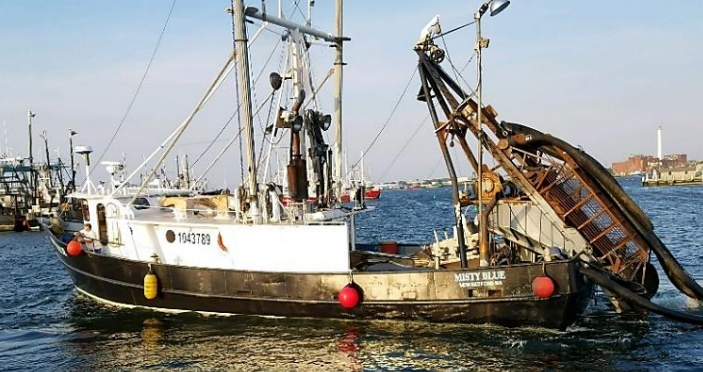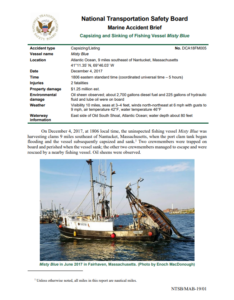The US NTSB issued an investigation report on the capsizing of the fishing vessel ‘Misty Blue’ in December 2017, in the Atlantic Ocean, which resulted in two fatalities and marine pollution. The report identified flooding of the port clam tank as the key cause of the accident.
The incident
On December 4, 2017, at 1806 local time, the uninspected fishing vessel Misty Blue was harvesting clams 9 miles southeast of Nantucket, Massachusetts, when the port clam tank began flooding and the vessel subsequently capsized and sank.
Two crew members were trapped on board and perished when the vessel sank; the other two crewmembers managed to escape and were rescued by a nearby fishing vessel. Oil sheens were observed, as about 2,700 gallons diesel fuel and 225 gallons of hydraulic fluid and lube oil were onboard.
Probable cause
- The National Transportation Safety Board determines that the probable cause of the capsizing and sinking of fishing vessel Misty Blue was flooding of the port clam tank from an undetermined point of ingress, which led to a decreased freeboard and a list allowing boarding seas to be trapped on deck, thereby decreasing the vessel’s stability.
- Contributing to the sinking was the relatively small freeing port area of the vessel, which likely increased water accumulation on deck.
Analysis
The investigation found that the vessel underwent several conversions and configuration modifications during its lifetime. The Misty Blue’s last stability analysis in 2009 took place several years before the current owner modified the vessel (by adding a crane, a clam dredge gantry frame, a hopper dump bin, other fishing equipment, and a vibrator/shaker system).
These changes were done without a professional naval architect reassessing the vessel’s stability, which, although not required by regulation, would have been prudent.
However, the Coast Guard MSC’s post-accident report found that the vessel, as configured and loaded at the time of the sinking, would have “likely” met the intact stability criteria for a vessel of similar size and service.
Given that the vessel likely had a stability margin, the reported flooding of the portside clam tanks would have been the initiating event that ultimately sank the vessel. Potential points of water ingress could have been the clam tank fill and drain lines, or a hull breach.
Additionally, underwater examination of the wreckage revealed that at least three watertight bulkhead cable penetrations below deck were not properly sealed or made watertight. These or potentially other non-watertight cable penetrations may have led to progressive flooding between spaces, thereby decreasing reserve buoyancy and stability.
Explore more herebelow:































































